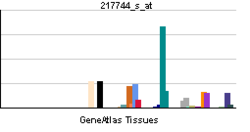- PERP
-
PERP, TP53 apoptosis effector Identifiers Symbols PERP; KCP1; KRTCAP1; PIGPC1; RP3-496H19.1; THW; dJ496H19.1 External IDs OMIM: 609301 MGI: 1929938 HomoloGene: 11098 GeneCards: PERP Gene Gene Ontology Molecular function • structural molecule activity
• protein bindingCellular component • nucleus
• nucleolus
• cytoplasm
• Golgi apparatus
• plasma membrane
• integral to membrane
• cell junction
• desmosomeBiological process • apoptosis
• cell adhesionSources: Amigo / QuickGO RNA expression pattern 
More reference expression data Orthologs Species Human Mouse Entrez 64065 64058 Ensembl ENSG00000112378 ENSMUSG00000019851 UniProt Q96FX8 Q9JK95 RefSeq (mRNA) NM_022121 NM_022032.4 RefSeq (protein) NP_071404 NP_071315.1 Location (UCSC) Chr 6:
138.41 – 138.43 MbChr 10:
18.56 – 18.58 MbPubMed search [1] [2] p53 apoptosis effector related to PMP-22 is a protein that in humans is encoded by the PERP gene.[1][2]
PERP is a direct transcriptional target of p53.References
- ^ Hildebrandt T, Preiherr J, Tarbe N, Klostermann S, Van Muijen GN, Weidle UH (Dec 2000). "Identification of THW, a putative new tumor suppressor gene". Anticancer Res 20 (5A): 2801–9. PMID 11062687.
- ^ "Entrez Gene: PERP PERP, TP53 apoptosis effector". http://www.ncbi.nlm.nih.gov/sites/entrez?Db=gene&Cmd=ShowDetailView&TermToSearch=64065.
Further reading
- Maruyama K, Sugano S (1994). "Oligo-capping: a simple method to replace the cap structure of eukaryotic mRNAs with oligoribonucleotides.". Gene 138 (1-2): 171–4. doi:10.1016/0378-1119(94)90802-8. PMID 8125298.
- Suzuki Y, Yoshitomo-Nakagawa K, Maruyama K, et al. (1997). "Construction and characterization of a full length-enriched and a 5'-end-enriched cDNA library.". Gene 200 (1-2): 149–56. doi:10.1016/S0378-1119(97)00411-3. PMID 9373149.
- Attardi LD, Reczek EE, Cosmas C, et al. (2000). "PERP, an apoptosis-associated target of p53, is a novel member of the PMP-22/gas3 family.". Genes Dev. 14 (6): 704–18. PMC 316461. PMID 10733530. http://www.pubmedcentral.nih.gov/articlerender.fcgi?tool=pmcentrez&artid=316461.
- Strausberg RL, Feingold EA, Grouse LH, et al. (2003). "Generation and initial analysis of more than 15,000 full-length human and mouse cDNA sequences.". Proc. Natl. Acad. Sci. U.S.A. 99 (26): 16899–903. doi:10.1073/pnas.242603899. PMC 139241. PMID 12477932. http://www.pubmedcentral.nih.gov/articlerender.fcgi?tool=pmcentrez&artid=139241.
- Bonkobara M, Das A, Takao J, et al. (2003). "Identification of novel genes for secreted and membrane-anchored proteins in human keratinocytes.". Br. J. Dermatol. 148 (4): 654–64. doi:10.1046/j.1365-2133.2003.05244.x. PMID 12752121.
- Mungall AJ, Palmer SA, Sims SK, et al. (2003). "The DNA sequence and analysis of human chromosome 6.". Nature 425 (6960): 805–11. doi:10.1038/nature02055. PMID 14574404.
- Ota T, Suzuki Y, Nishikawa T, et al. (2004). "Complete sequencing and characterization of 21,243 full-length human cDNAs.". Nat. Genet. 36 (1): 40–5. doi:10.1038/ng1285. PMID 14702039.
- Ihrie RA, Attardi LD (2004). "Perp-etrating p53-dependent apoptosis.". Cell Cycle 3 (3): 267–9. PMID 14726658.
- Gerhard DS, Wagner L, Feingold EA, et al. (2004). "The status, quality, and expansion of the NIH full-length cDNA project: the Mammalian Gene Collection (MGC).". Genome Res. 14 (10B): 2121–7. doi:10.1101/gr.2596504. PMC 528928. PMID 15489334. http://www.pubmedcentral.nih.gov/articlerender.fcgi?tool=pmcentrez&artid=528928.
- Otsuki T, Ota T, Nishikawa T, et al. (2007). "Signal sequence and keyword trap in silico for selection of full-length human cDNAs encoding secretion or membrane proteins from oligo-capped cDNA libraries.". DNA Res. 12 (2): 117–26. doi:10.1093/dnares/12.2.117. PMID 16303743.
Categories:- Human proteins
- Chromosome 6 gene stubs
Wikimedia Foundation. 2010.
